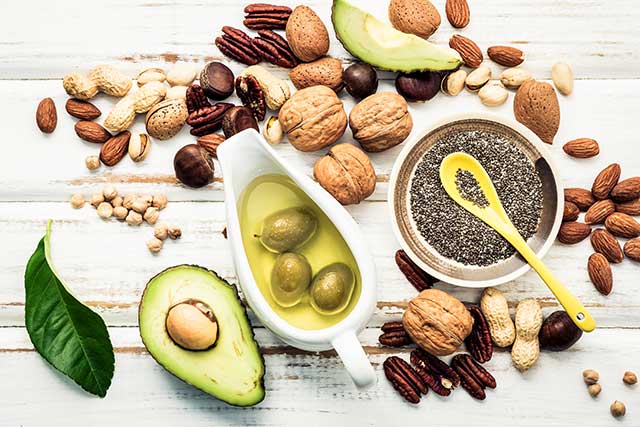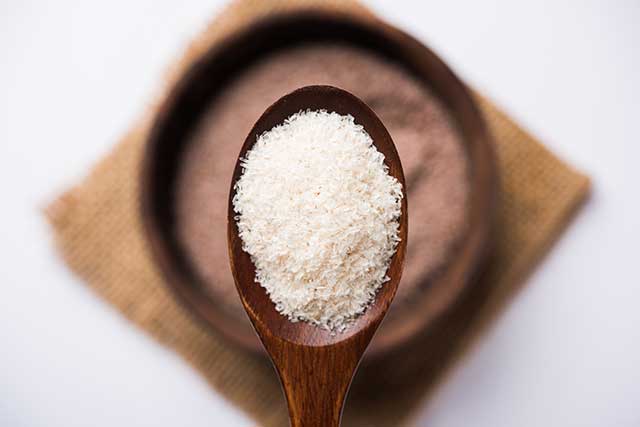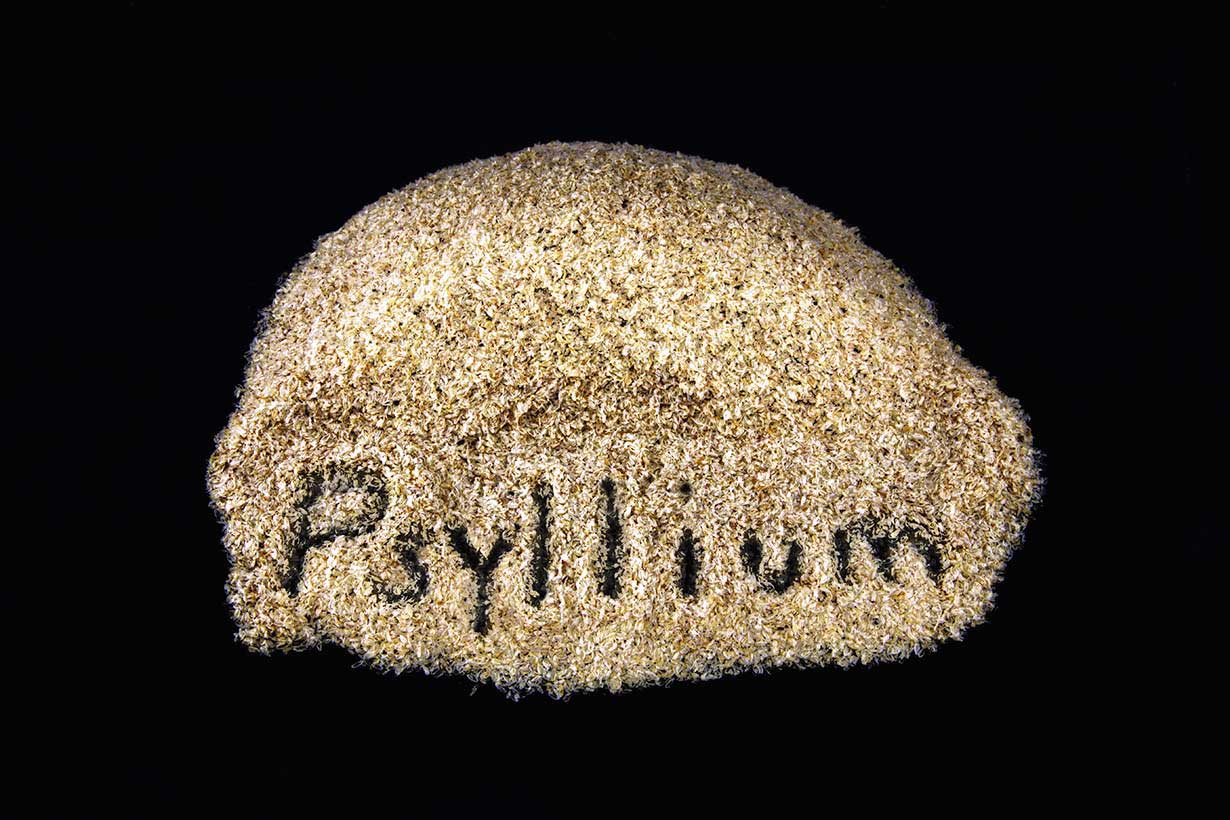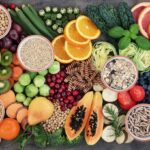Dietary fiber represents a diverse range of compounds that we can find in food.
Notably, a wide range of nutrition research suggests that fiber intake can have numerous health benefits.
In this article, we look at what dietary fiber is, what it does, and some potential benefits it may offer.
What Is Dietary Fiber?

Dietary fiber is a part of food that human digestive enzymes can’t break down.
Since humans lack the enzymes to break fiber down, we do not absorb dietary fibers in the small intestine like we do with other compounds in food.
There are two primary categories of dietary fiber: soluble and insoluble.
Soluble Fiber
Soluble fiber dissolves in water, and some sources of this fiber (such as psyllium husk) produce a thick and gel-like substance (1).
Also, this form of fiber is sometimes known as a ‘prebiotic’ fiber because bacteria in the human colon consume (and ferment) it.
This microbial fermentation process produces short-chain fatty acids. These fatty acids include acetate, butyrate, and propionate (2).
Research shows that soluble fiber delays gastric emptying (the amount of time food spends in the stomach). As a result, soluble fiber can have beneficial effects on satiety and the blood sugar response to carbohydrate-based meals (3).
Insoluble Fiber
Insoluble fibers do not dissolve in water and nor are they usually fermented by bacteria in the human gut (4).
However, bacteria can ferment some forms of insoluble fiber, such as resistant starch, in the colon (5).
Generally speaking, insoluble fiber is thought to add “bulk” to stools and help food pass through the digestive system quicker (6).
However, research shows that excessive amounts of insoluble fiber in some rare cases can contribute to constipation (7).
Types of Fiber
There are many different types of fiber.
In the table below, you can see some of the main dietary and synthetic fibers.
| Type of Fiber | Description and Food Sources |
|---|---|
| Alginic Acid | An insoluble fiber found in various brown seaweeds. |
| Beta-Glucans | A soluble prebiotic fiber that we can find in cereal grains, mushrooms, and seaweed, amongst other foods. |
| Cellulose | Cellulose is an insoluble fiber, and it is the main component of plant cell walls. Cereal grains are particularly rich in cellulose. |
| Chitin | An insoluble fibrous compound found in the exoskeletons of various shellfish such as crab, lobster, and shrimp. |
| Chitosan | Unlike chitin, chitosan dissolves in water, making it water-soluble. Chitosan is a supplement produced by treating chitin with an alkaline. |
| Fructans | There are several types of fructans, such as inulin and fructooligosaccharides. We can find fructans in fruit, vegetables, and cereal grains, and they are water-soluble. |
| Galactooligosaccharides | Galactooligosaccharides, such as raffinose and stachyose, are soluble fibers. Legumes and vegetables are the primary dietary sources. |
| Hemicellulose | Hemicellulose fibers are present in most plant cell walls. These fibers can be either soluble or insoluble, and we can find them in cereal grains, seeds, and vegetables, amongst other foods. The popular supplement psyllium is a type of hemicellulose fiber. |
| Lignans | Lignans are not a source of carbohydrate, but they are fiber-like phenolic compounds found in plant cell walls. |
| Pectins | Pectin is a water-soluble fiber found in plant cell walls. It is prevalent among fruits and vegetables. |
| Polydextrose | Polydextrose is a synthetic soluble fiber used as a food additive in various products. |
| Polyols | Polyols are otherwise known as sugar alcohols. While not technically fiber, they act in a similar way and avoid digestion. Gut bacteria ferment these polyols. |
| Resistant Maltodextrin | Resistant maltodextrin is a soluble fiber produced from corn starch and used as a food additive and supplement. |
| Resistant Starch | Found in foods such as cooked and cooled rice and potatoes and green bananas. Resistant starch resists digestion and undergoes bacterial fermentation in the gut. |
| Xanthan Gum | Xanthan gum is a soluble fiber made from the bacterial fermentation of various sugars. Xanthan gum is a commercial food additive. |
What Does Fiber Do? Functions and Benefits
Fiber may potentially have some positive health effects by;
- Acting as a prebiotic
- Reducing postprandial blood sugar responses
- Potentially improving satiety
- Lowering LDL cholesterol levels
- Producing short-chain fatty acids
- Potentially (observational evidence) reducing colorectal cancer risk
- Binding carcinogens and other toxins
We will now look at these potential functions and benefits in more detail.
Some Types of Fiber Are Prebiotics and Feed Gut Bacteria
Certain types of fiber act as prebiotics for beneficial gut bacteria, such as Bifidobacterium, to feed on (8).
To be specific, the types of dietary fiber that function as prebiotics include beta-glucans, fructans, galactooligosaccharides, resistant starch, and resistant maltodextrin (9).
Generally speaking, the average Western diet—high in carbohydrates and fat, but low in fiber—has resulted in the loss of gut microbiome diversity. Several researchers hypothesize that this depletion of human gut bacteria may be a risk factor for several chronic diseases (10).
Additionally, trials show that increasing dietary fiber intake leads to higher gut bacteria diversity (11, 12).
For instance, in a systematic review of 64 studies involving 2099 participants, higher dietary fiber intake led to “significantly greater” levels of lactobacillus and bifidobacterium (13).
Fiber Can Reduce Blood Sugar Responses To Carbohydrate-Based Meals
Fiber helps to slow the digestion of dietary carbohydrate, which can lead to a smaller postprandial (post-meal) blood sugar response.
Here is a summary of some recent studies in this area;
- In a randomized controlled trial, higher fiber intake at breakfast led to lower postprandial glucose levels (14).
- Adding water-soluble fibers (psyllium) to the diets of forty-two individuals with type two diabetes had a positive effect. In this randomized controlled trial, 10.5 grams of psyllium per day for eight weeks led to reduced fasting blood sugar (163 to 119 mg/dl), HbA1c (8.5% to 7.5%) and reduced glycemic responses (15).
- One trial found that adding 11.6 grams of fiber (resistant starch) to baking products reduced postprandial blood glucose by approximately 33% (16).
- A systematic review and meta-analysis of 28 human trials demonstrated that viscous fiber supplements improve markers of glycemic control (17).
As the research shows, higher fiber intake can have a beneficial impact on blood sugar responses.
Fiber is likely particularly important to meals with a high carbohydrate load, which would cause more significant glycemic responses.
May Improve Satiety Levels (and Indirectly Benefit Weight Maintenance)
Compared to refined carbohydrate, fibrous carbohydrate foods have a much greater impact on satiety levels (18).
In other words; choosing fiber-rich carbohydrate options rather than foods like white bread and pasta can better regulate appetite.
Additionally, higher levels of satiety reduce the likelihood of food cravings (19).
However, the consensus of research in this area suggests that dietary protein has the biggest impact on satiety (20, 21, 22).
Certain Types of Dietary Fiber Can Lower LDL Cholesterol Levels

Research shows that dietary fiber intake can decrease circulating levels of LDL cholesterol (23).
For instance, psyllium husk, which is a popular fiber supplement, traps and eliminates bile via the stool. When this happens, the body stimulates LDL clearance to produce more bile acids. As a result, blood levels of LDL cholesterol fall (24).
For this reason, increasing dietary fiber intake could be a useful lipid-lowering strategy for individuals wishing to lower their LDL levels (25).
On this note, several research papers have demonstrated that;
- In a systematic review and meta-analysis of 28 randomized controlled trials, viscous fiber, such as psyllium, significantly reduced levels of LDL cholesterol, non-HDL cholesterol, and apo B. Each of these markers has been associated with increased cardiovascular risk (26, 27).
- A further systematic review of 16 studies also demonstrated that psyllium fiber led to significant reductions in LDL, non-HDL cholesterol, and apo B (28).
- Randomized controlled trials also show that coconut fiber and flaxseed fiber may significantly reduce LDL and total cholesterol (29, 30).
Gut Bacteria Ferment Fiber Into Short-Chain Fatty Acids
Although human digestive enzymes can’t break down dietary fiber, the bacteria that reside in the human colon can.
In this location, the bacterial fermentation of dietary fiber produces end products known as short-chain fatty acids (SCFAs). These SCFAs include acetate, propionate, and butyrate (31).
A variety of research suggests that these SCFAs may have potential benefits for human health.
For example, these SCFAs interact with protein-coupled reactors in the body, which may improve immunity and help to suppress inflammation (32).
According to peer-reviewed research, SCFAs appear to modulate colonic function and various immune and inflammatory processes (33, 34).
More research in the way of human clinical trials is necessary to gain a better understanding of the potential benefits of SCFAs.
Dietary Fiber Is Associated With Reduced Colorectal Cancer Risk
Over recent years, a wealth of data—including systematic reviews—has associated dietary fiber intake with a reduction in colorectal cancer risk (35, 36, 37, 38).
As shown in the above-referenced studies, it appears that higher dietary fiber intake does have a statistically significant (and dose-response) effect.
For example;
- In a dose-response meta-analysis, increasing fiber intake by 10 grams per day reduced colorectal cancer risk by 9% (low-fiber intake) and 28% (high-fiber intake) (35).
- A further systematic review and meta-analysis of 11 large cohort studies had similar findings. In this study, individuals with the highest dietary fiber intake had a 14% lower risk of colon cancer compared to those with the lowest fiber intake (36).
Is It the Fiber – Or Something Else?
While fiber may be associated with reduced colorectal cancer incidence, it is important to remember that correlation does not necessarily equal causation.
For instance, there is an association, but no firm causational evidence that fiber lowers colorectal cancer risk.
In other words; it could be the actual fiber-containing foods that provide benefits, rather than the fiber itself.
In this case, certain compounds contained within fruit, vegetables, nuts, seeds, cereals, and other fiber-containing foods may have a protective effect (39, 40).
Furthermore, it could also be that eating more fibrous foods means eating less ultra-processed foods. According to research, ultra-processed foods have a detrimental impact on colorectal cancer risk (41).
That said, there are mechanisms through which fiber may have anti-cancer benefits. For example, dietary fibers can bind carcinogens and other toxins in the colon, which could help to inhibit carcinogenesis (42).
In summary; higher intake of fibrous foods is associated with reduced incidence of colorectal cancer. However, we can’t be certain it is the fiber that is responsible for this effect.
Fiber Intake Guidelines
According to the current Dietary Guidelines for Americans, the recommended daily fiber intake is 14 grams per 1000 calories of food intake (43).
This amount is equivalent to approximately 25 grams of fiber for adult females and 31 grams for adult males.
As always, what is right for one person may not be right for another.
Final Thoughts
As shown in this article, dietary fiber intake may have several potential health benefits.
Additionally, many foods that contain fiber, such as fruit and vegetables, are associated with benefits.
For more on dietary fiber, see this review of the common types of fiber supplements.


